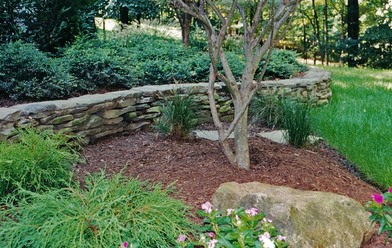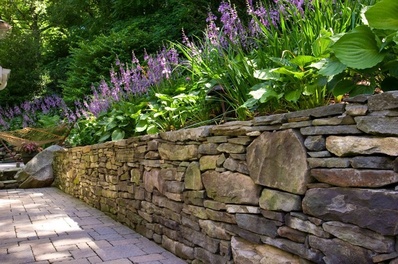 Incorporating walls into your landscape can serve multiple purposes: they may add privacy, may provide seating, may be used to retain land/soil and separate areas, they may simply serve to beautify your landscape or add a buffer to your property line. At Gardenin' Angels, we've built walls for customers throughout eastern Massachusetts to serve each of these purposes. Whatever reason you may be considering for installing a wall and whether you may install it on your own or with the help of a professional, we suggest you consider these points: 1. Create a solid base. The base of your wall should be dug several inches below grade and compacted to level. Filler, like gravel should be added before any stones or blocks. The base is the foundation for your entire wall, so it's worth spending some time preparing a solid base. 2. Prepare for water drainage You do not want water pooling around your wall. Over time this can disrupt the integrity of the wall. If your wall is at the base of even a slight slope, it will need additional drainage. A drainage pipe at the base will help release this water and avoid major problems. 3. Have your wall suit your style and function While the primary purpose of your wall may be to divide spaces or hold back soil, get creative in using your wall to serve additional function or create a more beautiful outdoor living space. Perhaps making it the height for additional seating or adding a trough at the top for planting small seasonal flowers can better suit you. And remember, walls don't have to be a straight line. Adding curves can add some dimension to your landscape.
0 Comments
 As much as we may like our neighbors, we don't want to watch them sunbathing, or weeding, or training their dog every time we go out to enjoy our yard. And perhaps they don't want to watch us swaying in the hammock every time they go outside. If your yard is lacking privacy, there are a few things you can do to make your outdoor space your own, peaceful - private - oasis. 1. Install a privacy fence The obvious solution for quick and easy privacy is to add a 6 foot fence around your property. There are a number of fence designs and materials to suit the style and architecture of your home as well as your preferences. Be sure to check with your local city/town as rules are different in each locality on how high a fence can be and how far it has to be from property lines. 2. Add natural screening with plantings By planting tall shrubs, trees, or hedges at your property line, you minimize the stark look of a fence and can have an even higher screen of privacy, as some plantings and trees can grow taller than six feet (typically the maximum allowed by local ordinances for fences). Just be sure to plant something that will not lose its leaves or coverage in New England's fall and winter seasons. 3. Add a stone wall Stone walls are a great way to add privacy, as they add texture to your property while using natural elements. Once built, they last a lifetime and always look timeless, which adds charm to any home. If a tall, stone wall seems a bit claustrophobic, consider a shorter stone wall that you can add plantings or a short fence on top of to really achieve that privacy and beauty. 4. Install a fountain or other water feature to minimize noise Sometimes you care less about what you see and more about what you hear. If chatty neighbors, busy traffic or even AC condenser units are bothersome to you, adding a fountain to your landscape may be the right fix. The running water can add a natural white noise while drowning out unpleasant sounds. |
Archives
February 2024
AuthorRodrigo Dos Anjos Categories
All
|
Gardenin' Angels, Landscape Management & Construction
A preferred landscaper, serving Southeastern Massachusetts
11 Renker Drive, Easton, MA 02375
774-284-1171
[email protected]
Privacy Policy • Terms of Use

 RSS Feed
RSS Feed